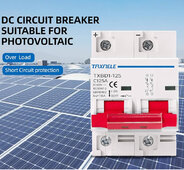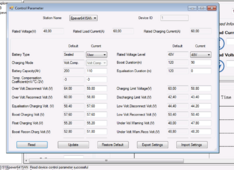You are using an out of date browser. It may not display this or other websites correctly.
You should upgrade or use an alternative browser.
You should upgrade or use an alternative browser.
Does it disconnect batteries or disconnector?
- Thread starter frankz66
- Start date
frankz66
New Member
I was also wondering if anyone can suggest me on Amazon which selector for 2 good quality 48V batteries in order to be able to select the life or agm batteries by following the procedure for turning off the inverter, in short a manual procedure. Thank you .
robbob2112
frankencord Doing more research, mosty harmless
The first is a breaker suitable for 125amps - you can use it as a disconnect. It is a little undersized for your use but would work if you had two tied together so if one is open the other closes. The problem is it needs a box to mount in.
For a selector switch you would need one that can switch both positive and negative at the same time. You do not want to leave the negative from both packs connected all the time.
A pair of these - select 150amp - they are enclosed molded case instead of needing a breaker box
Each pack would need its own fuse - since you are in Malta you can use the cheaper NH style and get the same protection as the class T here in the US
Then you can switch one on and one off - Since you don't need to pass any inspections and are not in the US that would work.
The rub would be if both were turned on at once and the batteries are not at the same voltage. Nothing would let out the smoke, but you want to avoid it.
This is the simplest way to do your battery bank switching. Make sure the wires are all capable of 150amp.
And from here on out I will let someone else answer since you want cheeper than what I am suggesting
For a selector switch you would need one that can switch both positive and negative at the same time. You do not want to leave the negative from both packs connected all the time.
A pair of these - select 150amp - they are enclosed molded case instead of needing a breaker box
Each pack would need its own fuse - since you are in Malta you can use the cheaper NH style and get the same protection as the class T here in the US
Then you can switch one on and one off - Since you don't need to pass any inspections and are not in the US that would work.
The rub would be if both were turned on at once and the batteries are not at the same voltage. Nothing would let out the smoke, but you want to avoid it.
This is the simplest way to do your battery bank switching. Make sure the wires are all capable of 150amp.
And from here on out I will let someone else answer since you want cheeper than what I am suggesting
mikefitz
Solar Wizard
- Joined
- May 28, 2020
- Messages
- 3,182
For 12 and 24 volt systems Blue Sea range are highquality,can suggest me on Amazon
Further investigation suggests you have a 48 volt system so the above are not rated for that.
I may have discussed the concept of having two different battery packs before. You could just connect the AGM and lithium together and charge/discharge in parallel. Use a charge voltage for lithium, 56.8 volts.
When running loads, your inverter, the lithiun will carry out most of the work until around 30% SOC when the AGM will add power.
It's possible the lithium pack alone will be enough for your needs and retire the AGM.
Last edited:
robbob2112
frankencord Doing more research, mosty harmless
For 12 and 24 volt systems Blue Sea range are highquality,
He is switching between two banks of 48v batteries - one is older AGM and the other is new LFP.
He has another thread where he asked about an automatic method to do the switching and describes in full what the system is.

battery backup switch
Hi everyone, I wanted to know if there is a simple way perhaps with a graphic diagram on how to manage at the cut off of the panels a 110 amps AGM 48v accumulation and a possible 100 amp lifepo4 accumulation. Also before dawn comes for example at 5 am the switch returns to the accumulation agm ...
frankz66
New Member
Thanks, why then are these switches made with the positive in common? As you wrote, then a disconnector with positive and negative as in the photo is better.For a selector switch you would need one that can switch both positive and negative at the same time. You do not want to leave the negative from both packs connected all the time.
frankz66
New Member
Mike if the English translation is correct you are saying to put AGM and Lifepo4 together or rather in parallel??For 12 and 24 volt systems Blue Sea range are highquality,
Further investigation suggests you have a 48 volt system so the above are not rated for that.
I may have discussed the concept of having two different battery packs before. You could just connect the AGM and lithium together and charge/discharge in parallel. Use a charge voltage for lithium, 56.8 volts.
When running loads, your inverter, the lithiun will carry out most of the work until around 30% SOC when the AGM will add power.
It's possible the lithium pack alone will be enough for your needs and retire the AGM.
mikefitz
Solar Wizard
- Joined
- May 28, 2020
- Messages
- 3,182
OK I understand, switching between packs may require inverter pre charge circuit if there is complete disconnection, and possible implications with the solar controller. As I discussed above a very simple option is to parallel the two packs.He is switching between two banks of 48v batteries
It's probable the AGM batteries are well past their best, they are not deep cycle heavy duty batteries, and it may be better to take them out of the system, and allow more efficient use of the available solar to charge the lithium and power loads .
mikefitz
Solar Wizard
- Joined
- May 28, 2020
- Messages
- 3,182
I was saying , you have a 48 volt lithium pack and a 48 volt AGM pack. Two 48 volt batteries. Connect these in parallel and charge with lithium settings. ( need suitable fuse on each pack pack for safety).English translation is correct you are saying to put AGM and Lifepo4 together or rather in parallel??
I an also adding the suggestion that you may not need the AGM to power your loads. There may be enough storage in the lithium pack.
frankz66
New Member
Mike, there are some users who have done it, but other 'expert' users said it is inadvisable for security reasons to do so. The reason seems to be linked to the fact that if, for example, one of the AGM series batteries (12Vx4) shorts out, the lithium batteries immediately deliver all their power to the AGM batteries, causing dangerous overheating. Furthermore, I believe that even if the charging voltages for the lithium I bought are similar, the charge could be unbalanced.OK I understand, switching between packs may require inverter pre charge circuit if there is complete disconnection, and possible implications with the solar controller. As I discussed above a very simple option is to parallel the two packs.
It's probable the AGM batteries are well past their best, they are not deep cycle heavy duty batteries, and it may be better to take them out of the system, and allow more efficient use of the available solar to charge the lithium and power loads .
frankz66
New Member
Mike you say to put in series between a positive for the agm and the positive of the life example 2 ANL of 100 amps?I was saying , you have a 48 volt lithium pack and a 48 volt AGM pack. Two 48 volt batteries. Connect these in parallel and charge with lithium settings. ( need suitable fuse on each pack pack for safety).
I an also adding the suggestion that you may not need the AGM to power your loads. There may be enough storage in the lithium pack.
frankz66
New Member
mikefitz
Solar Wizard
- Joined
- May 28, 2020
- Messages
- 3,182
Yes , fuse each pack. The idea of having the two packs in parallel, Is not ideal, but a method that some use.Mike you say to put in series between a positive for the agm and the positive of the life example 2 ANL of 100 amps?
A further point I am making is, do you need the AGM pack ?
Will the lithium alone power your loads?
frankz66
New Member
Mike, no I really don't need it, but I would like to use it as a backup. In the sense that if the lifepo4 batteries are a little flat and I need more energy I can use the agm ones. They are now about a year and a half old, and they work reasonably well.Yes , fuse each pack. The idea of having the two packs in parallel, Is not ideal, but a method that some use.
A further point I am making is, do you need the AGM pack ?
Will the lithium alone power your loads?
frankz66
New Member
To give you an idea of how things are going, I attach the graph at 9.15pm. I always have a 60W + 25W inverter load active. Now I will face the night with the refrigerator turned on and programmed thanks to the home assistant which switches off when the voltage reaches around 49.30V for a constant 5 minutes.
Attachments
frankz66
New Member
Hi Mike, this would be the sketch of what I would like to do with both batteries, unfortunately carrying out the procedure of turning off the inverter in case of need for energy. What do you think?Yes , fuse each pack. The idea of having the two packs in parallel, Is not ideal, but a method that some use.
A further point I am making is, do you need the AGM pack ?
Will the lithium alone power your loads?
Attachments
Similar threads
- Replies
- 6
- Views
- 263
- Replies
- 7
- Views
- 201
- Replies
- 4
- Views
- 251






